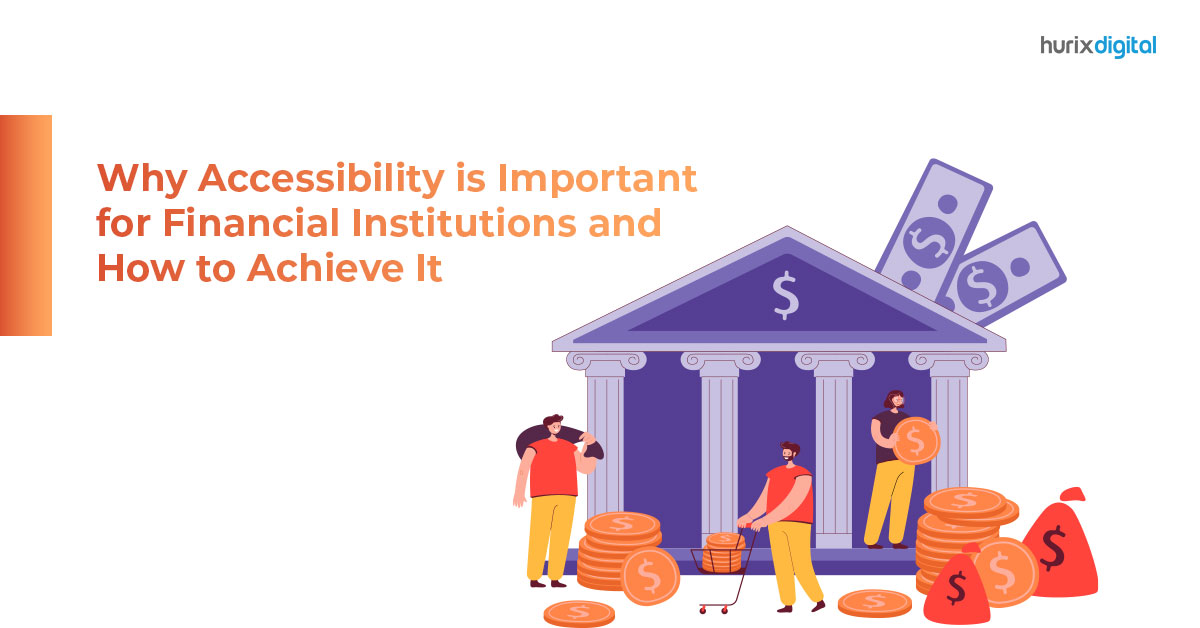
Why Accessibility is Important for Financial Institutions and How to Achieve It?
In today’s digital age, accessibility is not just a user-friendly feature but a legal requirement for financial institutions. It is essential to ensure that individuals with disabilities have equal access to financial services, products, and information.
In this blog, we will explore the importance of accessibility for financial institutions and delve into practical strategies to achieve it. From understanding the legal landscape to implementing inclusive design principles, this blog provides insights and guidance on how financial institutions can make their digital platforms, services, and information accessible to all individuals, regardless of their abilities.
So, let’s dive in!
Accessibility: A Brief Introduction
Accessibility refers to the design of products, services, or information that can be used and experienced by people with disabilities, as well as individuals with diverse abilities or needs. Accessibility aims to ensure that everyone, regardless of their disabilities, can access and participate in all aspects of society on an equal basis with others.
Accessibility is important for institutions to achieve because it promotes inclusion and equity. When businesses, educational institutions, government entities, and public facilities are accessible, people with disabilities or diverse abilities can fully participate in various activities, services, and opportunities. Financial institutions are no exception.
Top Reasons Why Accessibility is Essential for Financial Institutions
Accessibility is an essential aspect of financial institutions and the services they offer. It is widely accepted that providing access to bank accounts, loans, and other financial assistance to the public is a key factor for economic development. Here are seven reasons why accessibility is important for financial institutions:
- Enhanced customer experience: Accessibility enhances the customer experience by making it easier for customers to interact with financial institutions. Customers are more likely to use banking and financial services if they can do so conveniently.
- Increased customer loyalty: Customers who experience better accessibility are more likely to be loyal to their financial institution. Improved accessibility leads to better customer satisfaction, which builds customer loyalty.
- Improved customer service: Customer service portals can be made accessible through read-aloud features, multiple contact points, quicker access to a human representative, and many more methods. When customers can easily use services, the likelihood of staying engaged with the institution increases.
- Increased revenue: Accessibility can increase revenue by attracting new customers and encouraging existing customers to utilize services. This can also reduce costs related to customer acquisition.
- Improved access to credit: Accessibility makes it easier for a wider group of customers to access credit, which can benefit financial institutions and increase their lending opportunities.
- Financial inclusion: Accessibility helps expand financial inclusion, which provides financial services to people who are typically excluded from the financial sector. By providing services to those who would otherwise struggle to obtain them, banks are helping to promote economic growth and development.
- Regulatory compliance: Financial institutions must comply with legal and regulatory requirements, such as accessibility regulations. Adequate accessibility ensures that the institution is compliant and accessible to all, irrespective of users’ disabilities.
How Can Financial Institutions Achieve Accessibility?
Financial institutions have the power to improve the accessibility and lifestyle of people with disabilities. Here are seven ways financial institutions can achieve accessibility:
- Expand Accessible Technology: Financial institutions should offer products, services, and technologies compatible with assistive technology for people with disabilities.
- Train Employees: Reliable customer service is important to ensure accessibility. Financial institutions should provide comprehensive training to their employees on how to interact with customers with disabilities. Similarly, providing customer support in multiple languages and dedicated help centers can help customers improve their experience.
- Utilize digital technologies: Financial institutions should use digital technologies like mobile banking to make their services easily accessible. This helps customers who cannot physically go to a bank access their accounts. Furthermore, by offering online services such as online payments, financial institutions can make their services more accessible. These digital solutions should comply with Web Content Accessibility Guidelines (WCAG) to ensure accessibility for all users.
- Design for All: Social media channels can reach customers and inform them about the various services available. However, financial institutions should ensure that their online presence and digital products are designed for people with various abilities. This includes providing digital content with alt text, high contrast, captions, and more.
- Offer Accommodations: Financial institutions should offer reasonable accommodations and assistance to their customers with disabilities. This includes assisting with filling out forms, providing braille and tactile materials, etc.
- Update Policies and Processes: Financial institutions should review their products, policies, and processes to ensure they are accessible to people with disabilities. Furthermore, provide access to appropriate products and services tailored to the needs of different customer groups.
- Collaborate with Advocates: Financial institutions should collaborate with disability advocates to ensure their products, services, and locations are accessible to people with disabilities. Similarly, developing partnerships with community organizations will provide the opportunity for financial institutions to engage with people in a meaningful way.
By following these steps, financial institutions can make their services more accessible and provide a better customer experience.
The End Note
Accessibility is essential for financial institutions and organizations. Not only is it an inclusive policy, but financial institutions can benefit from increased customer satisfaction, brand perception, and revenue by taking the necessary steps toward accessibility.
Hurix Digital is a digital learning solutions company that specializes in providing web accessibility solutions for organizations. Hurrix’s web accessibility solutions are designed to help organizations meet legal requirements, promote inclusivity, and enhance their digital presence.
Our team of accessibility experts uses the latest assistive technologies and techniques to ensure that the client’s websites and digital content are fully accessible to all users, including those with disabilities.
Contact us to know more!





